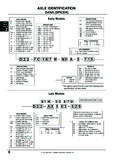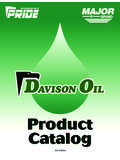Transcription of HSE:CRR 136/1998 workbook for chemical reactor …
1 ANNEX 10 NOMENCLATUREA cross-sectional flow area of relief system (m2)Aactualactual cross-sectional area of safety valve nozzle (m2)Aapproxapproximate cross-sectional flow area of relief system obtained fromscreening technique (m2) Aecross-sectional area of relief system in calorimeter used for directscaling test (m2)Ancross-sectional area of nozzle in safety valve (m2)Apcross-sectional flow area of relief pipe (m2)ARcross-sectional area of reactor (m2)aconstant in Antoine equation (ln N/m2)aswparameter defined by equation ( )bconstant in Antoine equation (K ln N/m2)bswparameter defined by equation ( )Cspecific heat capacity (J/kgK)Cfliquid specific heat capacity (J/kgK)average "liquid" specific heat capacity, taking account of the presenceCfof solids (J/kgK)Cfeliquid specific heat capacity in small-scale calorimetric test (J/kgK)CfRliquid specific heat capacity at relief pressure conditions (J/kgK)
2 CDdischarge coefficientC0correlating parameter in level swell correlationsCpspecific heat capacity at constant pressure (J/kg K)Cvspecific heat capacity at constant volume (J/kg K)Csspecific heat capacity of solid (J/kgK)Csvparameter defined by Table defined by equation ( )Drelief system diameter (m)Derelief system diameter in small-scale experimental test (m)dP/dtrate of pressure rise (N/m2 s)(dP/dt)maxmaximum rate of pressure rise (N/m2 s)(dP/dt)Rrate of pressure rise at relief pressure or at start of two-phase relief,whichever is higher (N/m2 s)dPG/dtrate of rise of gas partial pressure (N/m2 s)dPv/dtrate of rise of vapour pressure (N/m2 s)dPv/dTslope of vapour pressure curve (N/m2K)dT/dtadiabatic rate of temperature rise due to the runaway reaction (K/s)(dT/dt)eadiabatic rate of temperature rise due to the runaway reaction asmeasured in calorimeter (K/s)(dT/dt)externalrate of temperature rise due to external heating (K/s)(dT/dt)
3 Radiabatic rate of temperature rise due to the runaway reaction at reliefpressure (K/s)(dT/dt)reactionadiabatic rate of temperature rise due to the runaway reaction alone(K/s) workbook FOR chemical reactor RELIEF SYSTEM SIZING231(dT/dt)madiabatic rate of temperature rise due to the runaway reaction atmaximum accumulated pressure (K/s)(dT/dt)maxmaximum adiabatic rate of temperature rise (K/s)(dT/dt)measuredtotal measured rate of temperature rise (K/s)(dT/dt)maxadiabatic rate of temperature rise due to the runaway reaction at pointof maximum reaction rate (K/s)EAactivation energy (J/kmol)FBback pressure correction factorFDdynamic load factorFfrictional correction factor in Fauske's method (see )Fiflow inclination numberF0safety factor for uncertainty in relief sizing fFanning friction factorGtwo-phase mass flow rate per unit flow area (kg/m2 s)Gcchoked two-phase mass flow rate per unit flow area (kg/m2 s)
4 Gc*dimensionless choked two-phase mass flow rate per unit flow area Gggas or vapour-only mass flow rate per unit flow area (kg/m2s)GGtwo-phase mass flow rate per unit flow area for gassy two-phase flow(neglecting vapour pressure in a hybrid system) (kg/m2 s)GLlaminar two-phase mass flow rate per unit flow area (kg/m2 s)GLelaminar two-phase mass flow rate per unit flow area obtained inexperimental test (kg/m2 s)Gnozzletwo-phase mass flow rate per unit flow area for a frictionless nozzle(kg/m2 s)GRtwo-phase mass flow rate per unit flow area at relief pressure (kg/m2 s)Gvtwo-phase mass flow rate per unit flow area for flashing two-phase flow(neglecting permanent gas in a hybrid system) (kg/m2 s)GTturbulent two-phase mass flow rate per unit flow area (kg/m2 s)G*dimensionless G(G/Gc)frictioncorrection factor in Omega method for friction(G/Gc)backpressurecorrection factor in Omega method for non-choked flowgacceleration due to gravity (m/s2)hfglatent heat of vaporisation (J/kg)
5 Hstatic head change (m)jgsuperficial gas/ vapour velocity in reactor (m/s)kisentropic coefficient Knumber of velocity heads lostKfittingsnumber of velocity heads lost in pipe fittingsKGconstant in equation ( )KSparameter in equation ( )Lequivalent length of vent line (m)LEequivalent length (m)mmass in reactor (kg)memass in calorimetric test (kg)mfmass of liquid in reactor (kg)mmmass remaining in reactor at maximum accumulated pressure (kg) mRmass in reactor at relief pressure (kg)msmass of solid in reactor (kg)MWmolecular weight (relative molecular mass)Ppressure (N/m2 abs.)
6 workbook FOR chemical reactor RELIEF SYSTEM SIZING232 Paatmospheric pressure (N/m2 abs.)PBback pressure (N/m2 abs.)Pemeasurement pressure in calorimeter (N/m2 abs.)PEpressure at the exit of the relief pipe (N/m2 abs.)PGpartial pressure of gas (N/m2 abs.)Piinitial total pressure (at start of calorimetric test) (N/m2 abs.)Pmmaximum accumulated pressure (N/m2 abs.)Ppgpartial pressure of pad gas (N/m2 abs.)Ppgiinitial partial pressure of pad gas (N/m2 abs.)PRrelief pressure (N/m2 abs.)PRepressure in calorimeter corresponding to full-scale relief pressure (N/m2abs.)
7 Ptestimated downstream pressure for calculation of Omega (seeequation ( ) (N/m2 abs.)PTcthermodynamic critical pressure (N/m2 abs.)Pvvapour pressure (N/m2 abs.)Pviinitial vapour pressure (N/m2 abs.)P0stagnation pressure (in upstream equipment) (N/m2 abs.) Pdifference between maximum pressure and relief pressure (N/m2) P/ Tapproximate slope of pressure versus temperature curve (N/m2K)qheat release rate per unit mass of reacting mixture (W/kg)qmodifiedheat release rate per unit mass of reacting mixture modified forpresence of external heating (W/kg)average heat release rate per unit mass of reacting mixture (W/kg)qQGvolumetric rate of permanent gas evolution in the reactor (m3/s)QGmaxpeak volumetric rate of permanent gas evolution in the reactor (m3/s))
8 QHEAT external heating rate (W)Qvvolumetric rate of vapour generation in reactor (m3/s)Qvmaxpeak volumetric rate of vapour generation in reactor (m3/s)Runiversal gas constant (J/kmol K)ReReynolds numberrefreference numberRFreaction force at a bend (N)Ttemperature (K)Tctemperature in containment vessel of bench-scale calorimeter (K)Tetemperature in calorimetric test cell (K)Tiinitial temperature (at start of calorimetric test (K)TRtemperature at relief pressure (K)T0temperature at stagnation condition at inlet to relief system (K)TFthrust (N)TTcthermodynamic critical temperature (K) Ttemperature difference between the temperatures at the relief pressureand maximum accumulated pressure (K) THtemperature change in a closed vessel as the pressure of a hybridsystem rises from the relief pressure to the maximum accumulatedpressure (K)ttime (s)temptytime from start of venting until reactor is empty (s))
9 Tmtime from start of venting corresponding to maximum accumulatedpressure (s) workbook FOR chemical reactor RELIEF SYSTEM SIZING233 tBBoyle time: time for pressure to rise from relief pressure to maximumpressure in an adiabatic closed vessel test (s) temptytime to empty reactor by homogeneous two-phase relief (s)characteristic bubble rise velocity (m/s)U uvelocity (m/s)vspecific volume (m3/kg)v0specific volume at stagnation conditions at inlet to relief system (m3/kg)vfliquid specific volume (m3/kg)vfgdifference between vapour and liquid specific volumes (m3/kg)
10 Vtspecific volume at estimated downstream pressure for calculation ofOmega (see equation ( )) (m3/kg)Vvolume of reactor (m3)Vevolume of gas-space within calorimeter, including the containmentvessel volume for an open test (m3)Vfvolume of liquid space in reactor (m3)VfRvolume of liquid space in reactor at relief pressure (just beforeoperation of relief system) (m3)Vgvolume of gas space in reactor (m3)VgRvolume of gas space in reactor at relief pressu













